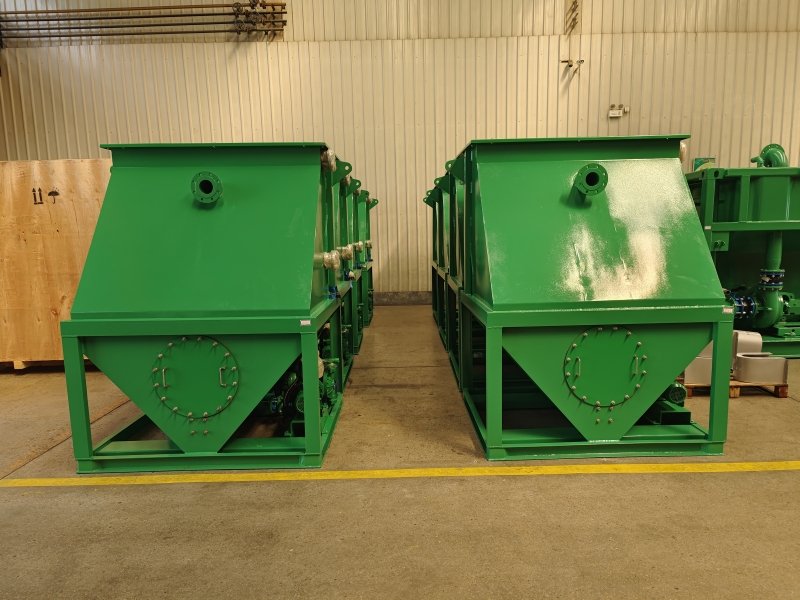Inclined Plate Clarifier For Oil/Water Separation

Inclined Plate Clarifier for Oil/Water Separation: An In-depth Analysis
Introduction
In industrial processes, managing wastewater with a significant oil and water mixture is a critical challenge. Efficient separation of these elements is vital for environmental compliance and operational efficiency. One of the more advanced and effective solutions for this task is the inclined plate clarifier (IPC). This article aims to offer a comprehensive overview of IPCs, their design principles, operational mechanisms, advantages, limitations, and application scenarios, emphasizing their role in oil/water separation.
The Fundamental Principles of Oil/Water Separation
Before diving into the specifics of IPCs, it’s essential to understand the basic principles of oil/water separation. Oil and water are immiscible liquids often encountered together in various industrial effluents. The key to separating them lies in exploiting their differences in density. Oil typically has a lower density than water, causing it to float when the mixture is left undisturbed. Industrial oil/water separation methods harness this principle through physical, chemical, and mechanical means to drive efficient partition.
Overview of the Inclined Plate Clarifier
The inclined plate clarifier is a piece of equipment designed to enhance the sedimentation process for liquid-solid separation. By extension, it also proves highly effective in oil/water separation. The core operational principle of IPCs revolves around increasing the effective settling area through the use of inclined plates or tube settlers. These plates create multiple laminar flow paths, which enhance the settling rate of suspended particles or immiscible liquids.
Design and Construction
Key Components
-
- Influent Chamber: This is where the oil/water mixture is fed into the clarifier. It often includes a distribution system to ensure uniform flow.
- Influent Chamber: This is where the oil/water mixture is fed into the clarifier. It often includes a distribution system to ensure uniform flow.
-
- Inclined Plates/Tubes: These are the defining components of the IPC. They are arranged at an angle (typically between 45° and 60°) to the horizontal plane, creating a broad surface area for separation.
- Inclined Plates/Tubes: These are the defining components of the IPC. They are arranged at an angle (typically between 45° and 60°) to the horizontal plane, creating a broad surface area for separation.
-
- Effluent Weir: This component directs the separated water towards the outlet, ensuring a constant flow rate.
- Effluent Weir: This component directs the separated water towards the outlet, ensuring a constant flow rate.
-
- Sludge Hopper: This is where the separated oil and sludge settle, eventually being removed from the system.
- Sludge Hopper: This is where the separated oil and sludge settle, eventually being removed from the system.
-
- Support Structure: The frame that holds all these components together, typically made of corrosion-resistant materials like stainless steel or durable polymers.
Working Principle
When the oil/water mixture enters the IPC, it flows upward between the inclined plates. Due to the reduced flow path and increased surface area, oil droplets and suspended particles settle more quickly on the plates. Water, now devoid of oil and particulates, moves to the effluent weir and exits the system. The accumulated oil and sludge slide down the plates by gravity and are collected in the sludge hopper for removal.
Operational Mechanisms
Fluid Dynamics and Settling
The inclined plates significantly alter the fluid dynamics within the clarifier. By reducing the height each particle or droplet needs to travel, IPCs lower the residence time required for effective separation. The plates also foster laminar flow conditions, minimizing turbulence and promoting a gentle, orderly settling process.
Coalescence Effect
During the separation process, smaller oil droplets colliding with or adhering to the inclined plates coalesce into larger droplets. This coalescence further aids in the effective separation of oil from water, as larger droplets rise more quickly due to increased buoyancy.
Gravity and Density Differences
While gravity continues to act uniformly on all components in the mixture, the difference in density between oil and water enhances the separation. The inclined design amplifies the effect of gravity, encouraging the denser water to settle away from the lighter oil.
Advantages of Inclined Plate Clarifiers
-
- Increased Efficiency: IPCs dramatically increase the surface area available for separation, improving settling rates and overall efficiency.
- Increased Efficiency: IPCs dramatically increase the surface area available for separation, improving settling rates and overall efficiency.
-
- Compact Design: The inclined plate arrangement allows for a more compact system compared to traditional clarifiers, saving valuable floor space.
- Compact Design: The inclined plate arrangement allows for a more compact system compared to traditional clarifiers, saving valuable floor space.
-
- Reduced Sludge Volume: Efficient separation means less volume of sludge to manage, lowering disposal costs.
- Reduced Sludge Volume: Efficient separation means less volume of sludge to manage, lowering disposal costs.
-
- Scalability: IPCs can be easily scaled up or down to meet varying operational demands.
- Scalability: IPCs can be easily scaled up or down to meet varying operational demands.
-
- Low Maintenance: With fewer moving parts and a straightforward design, IPCs tend to require less maintenance than other separation systems.
- Low Maintenance: With fewer moving parts and a straightforward design, IPCs tend to require less maintenance than other separation systems.
-
- Environmental Compliance: By effectively separating oil from water, IPCs help industries meet stringent environmental regulations.
Limitations and Challenges
No system is without its drawbacks, and IPCs are no exception. Understanding these limitations is crucial for optimizing their use:
-
- Initial Cost: The upfront investment in IPCs may be higher than traditional clarifiers. However, this is often offset by lower operational costs.
- Initial Cost: The upfront investment in IPCs may be higher than traditional clarifiers. However, this is often offset by lower operational costs.
-
- Clogging and Fouling: The plates can become fouled with oil or particulates over time, requiring periodic cleaning to maintain efficiency.
- Clogging and Fouling: The plates can become fouled with oil or particulates over time, requiring periodic cleaning to maintain efficiency.
-
- Flow Rate Limitations: IPCs are optimal for specific flow rates. Deviating significantly from these rates can reduce performance.
- Flow Rate Limitations: IPCs are optimal for specific flow rates. Deviating significantly from these rates can reduce performance.
-
- Material Compatibility: Depending on the industrial effluent, materials used in IPC construction must be chosen carefully to resist corrosion and chemical damage.
Applications of Inclined Plate Clarifiers in Oil/Water Separation
Petrochemical Industry
In refineries and petrochemical plants, IPCs are central to wastewater treatment processes. They help separate crude oil from water, ensuring that effluents meet environmental discharge standards.
Metalworking and Machining
Cutting fluids and coolants used in metalworking contain significant amounts of oil. IPCs efficiently separate these oils, allowing the recycled water to be reused in the process, thus reducing the overall consumption of fresh water.
Food Processing
Effluents in the food processing industry often contain vegetable oils and fats. IPCs help in separating these components, enabling the treated water to be reused or safely discharged into water bodies.
Municipal Wastewater Treatment
In municipal settings where wastewater contains oils from domestic sources, IPCs facilitate the removal of these contaminants, contributing to cleaner, safer water for the community.
Case Studies: Real-world Applications
Case Study 1: Refinery Wastewater Treatment
A mid-sized refinery in Southeast Asia faced challenges with high oil content in its wastewater, affecting compliance with local discharge standards. The installation of an IPC system resulted in a 90% reduction in oil content, translating to substantial savings in environmental fines and enhanced operational efficiency.
Case Study 2: Metalworking Facility
A European metalworking facility integrated IPCs into their coolant recycling process. The improved separation efficiency allowed them to reuse 80% of their coolant water, significantly cutting down on water purchase and disposal costs.
Future Trends and Innovations
Automation and Smart Technologies
The integration of sensors and automation in IPCs is a promising trend. Real-time monitoring and adjustments can optimize separation efficiency, reduce downtime, and predict maintenance needs.
Advanced Materials
New materials with enhanced anti-fouling and corrosion-resistant properties can extend the lifespan of IPCs, further reducing maintenance and operational costs.
Hybrid Systems
Combining IPCs with other separation technologies, such as dissolved air flotation (DAF) or membrane filtration, can create highly efficient hybrid systems designed for specific industrial needs.
Best Practices for Optimizing IPC Performance
-
- Regular Maintenance: Periodic cleaning of plates and removal of sludge build-up ensures optimal performance.
- Regular Maintenance: Periodic cleaning of plates and removal of sludge build-up ensures optimal performance.
-
- Flow Rate Management: Maintaining the designed flow rate prevents disturbances in the separation process.
- Flow Rate Management: Maintaining the designed flow rate prevents disturbances in the separation process.
-
- Material Selection: Choosing appropriate materials for construction based on the nature of the effluent can prevent corrosion and enhance durability.
- Material Selection: Choosing appropriate materials for construction based on the nature of the effluent can prevent corrosion and enhance durability.
-
- Training and Monitoring: Ensuring that operators are well-trained and that the system is continuously monitored can preempt many operational issues.
Conclusion
Inclined plate clarifiers offer one of the most efficient and effective solutions for oil/water separation in various industries. While they come with certain limitations, the advantages they provide in terms of efficiency, compactness, and environmental compliance far outweigh these drawbacks. As technologies advance and environmental regulations become increasingly stringent, IPCs will likely continue to play a vital role in industrial wastewater management.
Whether in petrochemical plants, metalworking shops, food processing facilities, or municipal wastewater treatments, IPCs empower industries to manage their effluents more effectively. Through continuous innovation and adherence to best practices, these systems ensure that both operational efficiencies and environmental responsibilities are met.

